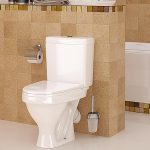Due to its attractive appearance and many positive operational characteristics, the laminate quickly gained popularity as an inexpensive flooring. Bribed by the apparent external ease of installation, many apartment owners take on the independent laying of the laminate. Ignorance or non-observance of installation technology often causes unfortunate errors that entail alteration of the floor and a complete replacement of the laminate.

The most common defect in laying laminate flooring is the expansion of the coating. It occurs for two reasons. Like any other material, a laminate has the ability to change its geometric dimensions depending on the humidity of the air and its temperature. If before installing the laminate it was stored in the cold, then before laying the material must be "lay back" at room temperature for at least two days. Installation of cold boards, will cause their expansion when heated and further expansion.

The same thing happens in the absence of gaps between the laminate and the walls around the perimeter of the room. They are just designed to compensate for the temperature or humidity expansion of the material. Such a defect can be eliminated only by completely shifting the floor covering with the replacement of deformed panels and observing a compensation gap of at least 10 mm.
The presence of loose joints occurs due to the use of poor-quality Chinese laminate, or when loose connection between individual panels. Chinese laminate is made from cheap raw materials, such boards rarely have the correct geometric shape, so it is impossible to get tight joints. If the material is high-quality, but when it was laid, the floor surface was not leveled or the boards were not tight enough to drive each other, gaps could occur between them. In both cases, there is only one way to eliminate it - complete re-laying of the coating and the use of high-quality material.

Chips of the corners of individual panels are also more likely to occur with cheap material. Part of the panels can move freely in the grooves. Therefore, the formation of the next row by tamping the material causes chips at the corners of the boards. The defect is eliminated only by replacing damaged panels.
Squeaks of the coating can occur within a few days after installation, due to the natural shrinkage of the panels. If the creaks continue for a long time, then most likely there are several reasons. This can be caused by an uneven floor screed or the destruction of its upper layer, as well as the use of an excessively thick substrate layer.

-
 Bamboo wallpapers: types, advantages, combinations
Bamboo wallpapers: types, advantages, combinations
-
 Is OSB cooker really dangerous and can it be used indoors
Is OSB cooker really dangerous and can it be used indoors
-
 Why very often experienced people use polystyrene for insulation
Why very often experienced people use polystyrene for insulation
-
 What roof will have to be repaired after 5 years of operation
What roof will have to be repaired after 5 years of operation
-
 What pipes are not suitable for laying a cold pipeline
What pipes are not suitable for laying a cold pipeline
-
 What pipes are better not to mount inside the wall
What pipes are better not to mount inside the wall
-
 Sandwich panels: economy, practicality, attractiveness
Sandwich panels: economy, practicality, attractiveness
-
 Which toilet tank spends a lot of water and poorly performs its function
Which toilet tank spends a lot of water and poorly performs its function
-
 Silk-screen wallpaper for walls
Silk-screen wallpaper for walls
-
 What signs indicate a fake building materials
What signs indicate a fake building materials
-
 Silk-screen wallpaper for walls
Silk-screen wallpaper for walls
-
 Why is marmoleum the best flooring?
Why is marmoleum the best flooring?
New publications are published daily on our channel in Yandex. Zen
Go to Yandex. Zen


